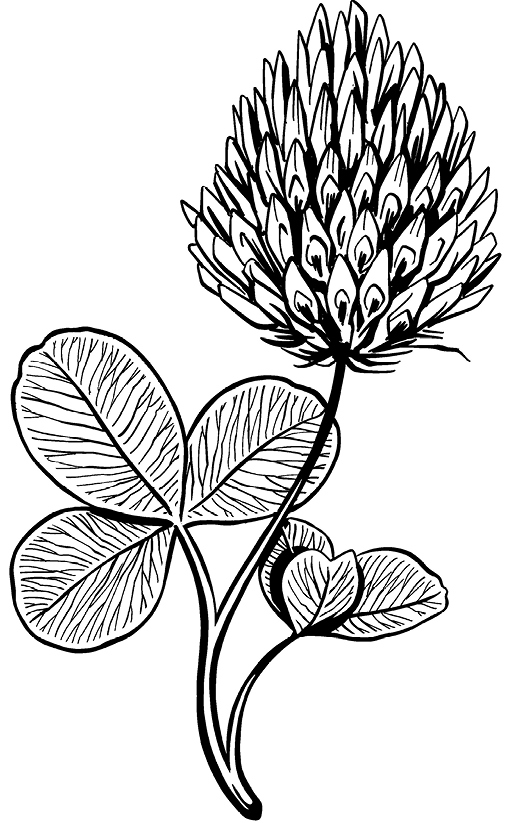Clover and Nurturing

Trifolium spp.
Growing up, the other neighborhood children and I often hunted for four-leaf clovers. I don’t remember any of us ever finding one, although sometimes friends tried to fake a four-leaf clover by twisting a fourth leaf around the usual three. There are many varieties of clover; most people are familiar with white clover, which is common in lawns. The small whitish globe is a favorite of bees and other pollinators. Red clover, which is taller and has a larger flower head, has been used as a healing herb for respiratory concerns, skin conditions, and its general restorative qualities. All clover leaves and flowers are edible, and the red clover looks beautiful in salads. Clover flowers can be brewed for a sweet-tasting tea with a mild anise flavor.
Clover is in the family of plants known as the nitrogen fixers. Nitrogen fixing is an important function in the green world because nitrogen is essential for plant growth, but it is not always available to plants. The element is plentiful in the air; however, most plants can’t access it that way. Clover and other legumes have a relationship with nitrogen-collecting soil bacteria. The bacteria live in nodules on the roots of clover, pulling nitrogen from the air and converting it to an accessible form. When clover dies or is cut back, the nitrogen is released and made available to the soil and surrounding plants.
Clover provides this vital function for other plants and defines its energetic correspondence of nurturing. Nurturing provides or creates an environment where living organisms can be their best selves, one where they can blossom and come to fruition.
Nurturing is not always visible. If you dig up a clover plant, you could observe the nodules on the roots where bacteria are collecting nitrogen, but you wouldn’t be able to see what is happening. If you consider the nurturing role of parents, much of it is out of sight or incomprehensible to small children. It’s hard to explain to a child that going off to work and paying the mortgage is a way of nurturing them. There are hundreds of things parents do to provide a nurturing environment for their children, but they are not always visible.
Of course, nurturing is not something that only belongs to parents. Any time energy is focused on creating healthy environments, nurturing is taking place. It happens in communities, neighborhoods, and families, and it’s often part of the background unless you intentionally look for it. Planting trees and creating green space is a way to nurture communities. Family meals and quality time are a way to nurture your family and friends. Being intentional about self-care is a way to nurture yourself.
While holding on to this correspondence for the week, first be aware of how the green world nurtures and supports us by making life possible. Then observe where nurturing is happening in your life, relationships, and neighborhood.
Sometimes the lack of nurturing is what is most visible. In considering this correspondence, you can shift that perspective and tune in to the nurturing that is happening in the background, often unnoticed. Notice what is nurturing you and how you nurture others.
Morning Attunement Questions
• What connections do I have with clover and nurturing?
• Where else in the green world or in my life do I observe nurturing?
• What does this correspondence feel like?
• How can I describe the energetic attribute of nurturing in words or pictures?
• Where does this correspondence of nurturing resonate most strongly in or around my body or in my life?
Daily Integration Questions
• In what ways is the world reflecting clover and nurturing back to me?
• What nuances and shades of meaning do I notice about clover and nurturing?
Evening Reflection Questions
• Where and how did I experience clover or nurturing today?
• How did I embrace nurturing today?
• What wisdom does clover’s correspondence of nurturing bring to my life?